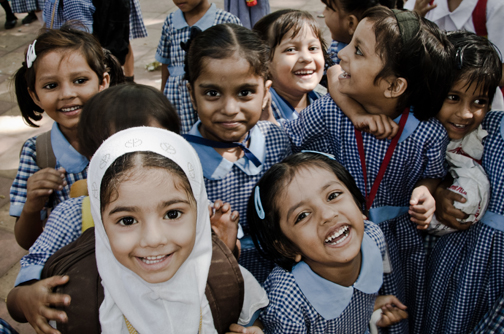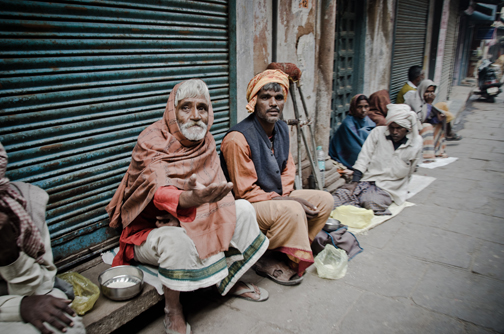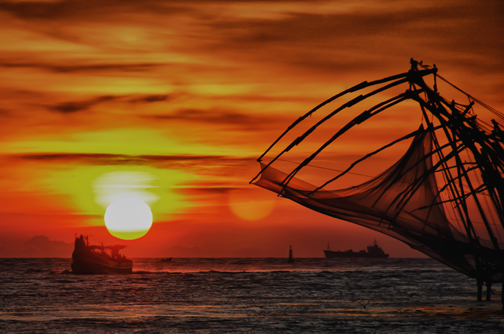From PHOTOWORKSHOP.COM
The Entropy and Extropy of India
By Michael Sloyer
Feb 6, 2012, 11:50
India, a palette of colors splashed and splattered across a gigantic
canvas, is abstraction personified. At first glance, the chaos and
crowds confound. Poverty is ubiquitous. Begging is persistent.
Everything is for sale. Honking is performed liberally amidst a backdrop
of repressive traffic. The concept of personal space does not exist; I
cook, you spit, and we just happen to do it in the same place. My
kitchen is your bathroom. His cricket field is her temple. Our bathing
ground is their cremation ground. Without explanation, people stare.
Public toilets are few and far between. But this chaos is only at first
glance.
 |
| (c)Michael Sloyer |
On second glance, the chaos becomes organized. The crowds become
endearing. Personal space doesn't seem all that necessary. And suddenly,
you find that you have 1.2 billion friends. India is a feast for the
senses, but for the visually and photographically inclined, this
dramatic country is especially thrilling.
This past November, my father and I embarked on a two week journey
across India. We set out with one piece of luggage each, an endless
supply of trail mix, and an intense desire to see, to learn, and to
experience. We were fortunate to travel with several basic comforts, but
this did not stop us from traveling with a backpacker's state of mind.
And as the eastern religions teach us, it is our state of mind, not our
physical body that is our ultimate reality.
 |
| (c)Michael Sloyer |
We began the journey in Delhi, the nation's capital and the epicenter of
all things chaotic. Armed with our Nikon DSLRs, we explored and
captured the narrow streets of Old Delhi where human foot traffic
competes with tuk tuks, rickshaws, automobiles, vespas, and the not so
occasional farm animal. From Delhi, we travelled to Agra, the home of
the Taj Mahal. Given all the hype about the Taj and its status as one of
the Seven Wonders of the Modern World, I had prepared myself for
disappointment. Could one building possibly be worth the near death
experience of traversing the roads from Delhi to Agra? But this
architectural gem did not disappoint. In fact, it did just the opposite.
It exhilarated, it provoked, and it inspired. As I entered through the
famed gateway, I marveled at the symmetry of the four imposing minarets,
the change in hue of the white marble against the setting sun, and the
cypress trees lining the reflection pools. The culmination of both man
and nature was utterly breathtaking. After this rather emotional
experience, we travelled on to Jaipur, the "pink city" and the capital
of the semi desert lands of Rajasthan. In Jaipur, we enjoyed the
opportunity to ride elephants up to the beautiful Amber Fort, explored
the palaces of the maharajas, and browsed the colorful gems shops that
seemed to be as omnipresent as the hawkers and beggars.
 |
| (c)Michael Sloyer |
Our next stop was Varanasi, the spiritual heart of India and for us, the
most visually charismatic. Life in the city began before sunrise as
thousands of Hindu pilgrims from all over the world headed down to the
banks of the Ganges River. As dawn broke over the river and the mist
lifted, we observed in reverence as the devotees performed ablutions in
the chilly waters. With their emergence from the water came feelings of
lightness and freedom as they had symbolically washed away the sins of
their former selves. Between clicks of the camera, my father and I
managed our own time for prayers and meditation. After sunrise, the ghats
along the banks burst into action: young Brahmin boys read aloud from
the Holy Scriptures, wandering Sadhus lined the narrow alleys with their
begging, and bowls elderly priests marked the faces of pilgrims with
colorful paints and holy ash. The cremation ghat embraced its role as
the last sacred stop of this human life; where bodies leave their
earthly pasts behind and embark on new journeys in the next cycle of
life.
 |
| (c)Michael Sloyer |
Night time in Varanasi brought a more festive atmosphere, though no less
spiritually and visually enchanting. The main event was the Hindu Aarti
Ceremony at the Ganges River ghats. Thousands of pilgrims and other
visitors watched in awe as the Brahmin priests swung their Aarti lamps.
The fire lit up the sky and incense smoke soon formed billowing opaque
clouds. The singing of the Om Jai Jagdish Hare, a devotional song to
Hindu deities, and the rhythmic beats of the myriad percussion
instruments combined to create a surreal atmosphere.
From Varanasi, we flew down south to the state of Kerala, where the
climate is tropical. We explored European fishing ports that felt like
journeys back in time and spent a night out on a houseboat drifting in
the peaceful backwaters. We relished the simple yet endless beauty of
the agrarian landscapes.
 |
| (c)Michael Sloyer |
The last stop on our trip was the rumbling, bustling city of Mumbai.
Here, one kilometer taxi rides lasted in excess of an hour as frustrated
drivers unconvincingly claimed that road rage does not exist. We
explored the hanging gardens, marveled at the arcing promenade (called
the "Queen's necklace") overlooking the Arabian Sea, and got a peak into
everyday life for the 21 million residents of the city. We even managed
to squeeze in a yoga session as we attempted to shake off the chronic
entropy in favor of a more centered consciousness. Yoga + India = zen.
 |
| (c)Michael Sloyer |
When all was said and done and we had made our way back to the states,
we reflected on our photos and our memories. The photos told a colorful
story of an Indian nation, its people and its history. The memories told
a slightly different story: one of personal growth as well as a deeper
understanding and appreciation for the diversity of our world.
India photos
Michael Sloyer
text and photos (c)Michael Sloyer
© Copyright by PHOTOWORKSHOP.COM





